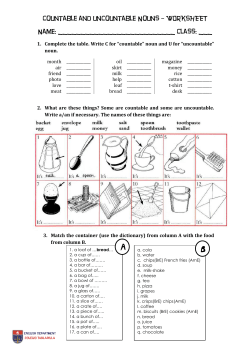
Homework 2 Solutions
Homework 2 Solutions
Problem 3.12.
The following table summarizes the properties of the three given orders:
Order Minimum Element Elements Without Immediate Predecessors
(i)
(1, 1)
(1, 1), (2, 1), (3, 1), . . .
(ii)
none
. . . , (1, 3), (1, 2), (1, 1), (2, 1), (3, 1), . . .
(iii)
(1, 1)
(1, 1)
Since order (ii) has no minimum element, it cannot have the same order type as (i) or (iii).
Moreover, order (i) has infinitely many elements without an immediate predecessor, while
order (iii) has only one such element, so (i) and (iii) have different order types as well. Thus
all three order types are different.
Problem 7.4.
Proposition. The set of all algebraic numbers is countable.
Proof. We can write the set of algebraic numbers as
S
p∈P
R(p), where P is the set of all monic
polynomials with rational coefficients, and R(p) denotes the set of roots of a polynomial p.
Each set R(p) is finite, so it suffices to show that P is countable.
Observe that P =
S∞
n=1
Pn , where Pn is the set of all monic polynomials of degree n with
rational coefficients. There is an obvious bijection Qn → Pn given by
(a0 , a1 , . . . , an−1 )
7→
xn + an−1 xn−1 + · · · + a1 x + a0 ,
and thus each Pn is countable. Then P is countable, being the countable union of countable
sets.
1
Proposition. The set of all transcendental numbers is uncountable.
Proof. We know that R = A ∪ T , where A is the set of algebraic numbers and T is the set
of transcendental numbers. If T were countable, then since A is countable it would follow
that R is countable, a contradiction. Thus T must be uncountable.
Problem 7.6.
We say that two sets A and B have the same cardinality if there is a bijection of A
with B.
Lemma. If B ⊂ A and there exists an injection f : A → B, then A and B have the same
cardinality.
Proof. Define families of sets {An }n∈Z+ and {Bn }n∈Z+ recursively as follows. Let A1 = A,
B1 = B, and for n > 1 let An = f (An−1 ) and Bn = f (Bn−1 ). Note that A1 ⊃ B1 , and thus
An ⊃ Bn for each n. Note also that B1 ⊃ A2 , and thus
A1 ⊃ B1 ⊃ A2 ⊃ B2 ⊃ A3 ⊃ · · · .
Using these sets, we can partition A and B as follows:
A = E ]
∞
]
(An − Bn )
and
n=1
where E is the complement of
B = E ]
∞
]
(An − Bn )
n=2
U∞
h(x) =
n=1 (An − Bn )
in A. Define a function h : A → B by the rule
f (x) if x ∈ An − Bn for some n,
x
if x ∈ E.
2
Since f is injective, f maps each An − Bn bijectively onto An+1 − Bn+1 . Then h maps each
An − Bn bijectively onto An+1 − Bn+1 and is the identity on E, and thus h maps A bijectively
onto B.
Theorem (Schroeder-Bernstein). If there are injections f : A → C and g : C → A, then A
and C have the same cardinality.
Proof. Suppose that such injections exist. Then f (C) ⊂ C, and f restricts to a bijection
A → f (C). The composition f ◦ g : C → f (C) is an injection, so by part (a) there exists a
bijection h : f (C) → C. Then h ◦ f is the desired bijection from A to C.
Problem 7.7.
Proposition. The sets (Z+ )ω and {0, 1}ω have the same cardinality.
Proof. We can define an injection f : {0, 1}ω → (Z+ )ω by
f (x1 , x2 , x3 , . . .) = (x1 + 1, x2 + 1, x3 + 1, . . .).
For the other direction, consider the function g : (Z+ )ω → {0, 1}ω that replaces each integer
n with a string of n zeroes followed by a one. For example,
g(3, 1, 2, 1, . . .) = (0, 0, 0, 1, 0, 1, 0, 0, 1, 0, 1, . . .)
Clearly g is an injection, so the two sets have the same cardinality by the Schroeder-Bernstein
Theorem.
3
© Copyright 2025










